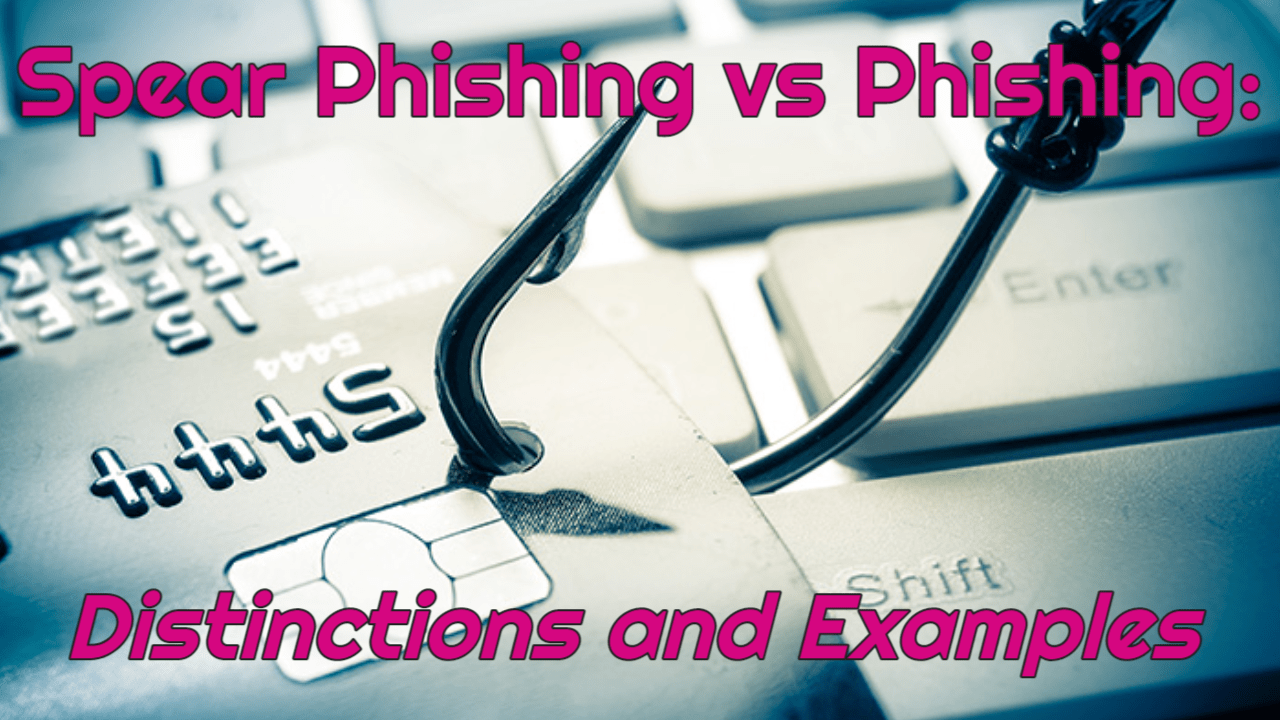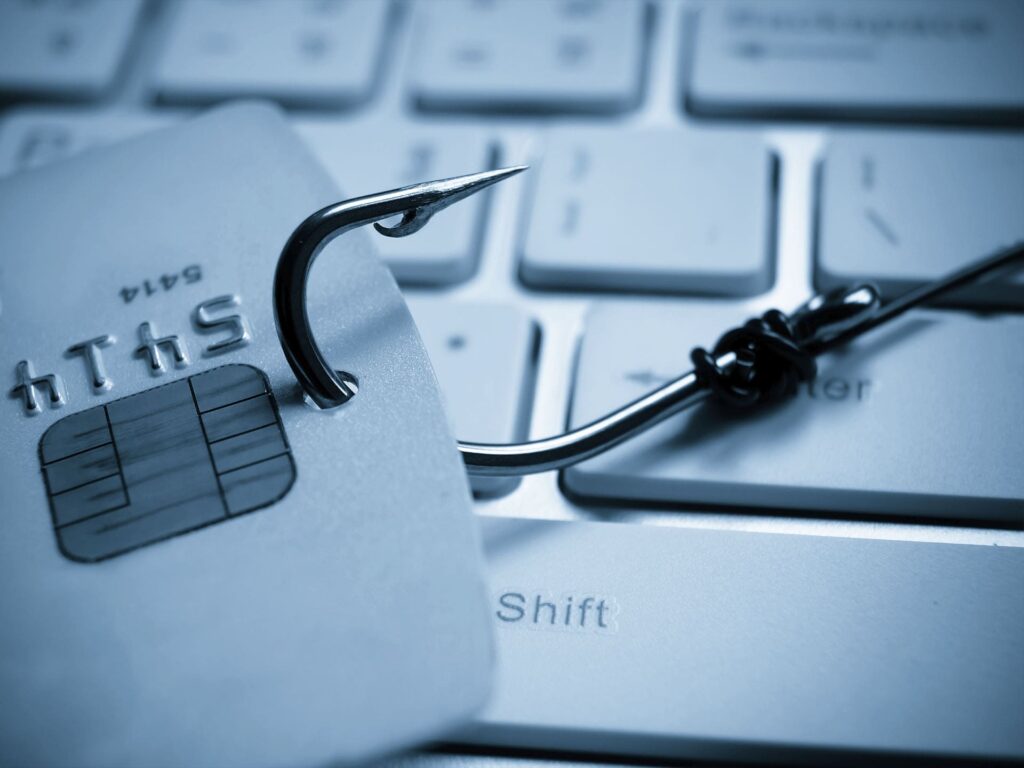Spear Phishing vs Phishing: What Exactly is Phishing?
Phishing is a hacking tactic in the digital realm akin to “casting a net.”
Phishing is a category of cybercrime in which someone impersonates a legitimate institution and contacts a target or targets via phone, email, or text message to trick people into disclosing sensitive information such as personally identifiable information, credit card and banking information, and passwords.
The information is then used to access critical accounts, resulting in financial loss and identity theft.
Attackers can get access to your online accounts and personal information, as well as access to change and compromise associated systems like POS terminals and order processing systems. Furthermore, entire computer networks are often hijacked until ransom money is paid.
Hackers are sometimes solely interested in collecting your personal and credit card information for financial benefit. In other circumstances, phishing emails are sent in order to gather employee login credentials or other sensitive information for use in more aggressive assaults against a specific group of individuals or firms.
How Does Phishing Work in Practice?
Phishing starts with a bogus email or other contact designed to lure a victim in. The communication is intended to look to have originated from a trustworthy source. If a victim falls for fraud, he or she is persuaded into supplying private information, which is typically posted on a fake website. Malware is frequently transferred onto the computer of the victim.
Cybercriminals begin by selecting a group of people to target. Then they construct email and SMS messages that look legitimate but contain harmful links, attachments, or lures that lead their victims to perform an unknown, risky action. To summarize:
*Phishers commonly use emotions like fear, curiosity, haste, and greed to convince victims to open files or click on links.
*Phishing attacks are intended to seem to be launched by legitimate businesses and people.
*Cybercriminals are continually changing and becoming more clever all the time.
*It just takes one successful phishing attempt to compromise your network and steal your data.
Phishing Tactics

Cybercriminals use three basic phishing strategies to steal information: maliciously constructed URLs, malware attachments, and false data-entry forms.
Maliciously Constructed URLs
Links, often known as URLs, are ubiquitous in emails but also common in phishing emails. Harmful links drive consumers to phony websites or websites that have been infected with malicious software, commonly known as malware. Malicious URLs can disguise themselves as trusted links and be placed in email logos and other pictures.
Malware Attachments
While these file attachments appear to be lawful, they include malware that has the potential to damage systems and their contents. In the event of ransomware, a form of virus, all data on a computer may become encrypted and unusable.
On the other hand, a keystroke logger may be installed to record anything a user enters, including passwords. It is also critical to understand that ransomware and malware infections may spread from one computer to another, including servers, external hard drives, and even cloud services.
False Data-Entry Forms
In these emails, users are urged to provide personal information such as user IDs, passwords, payment card information, and phone numbers. Once people give their information, fraudsters can utilize it to their advantage.
Spear Phishing vs Phishing: What Exactly is Spear Phishing?
Spear Phishing vs Phishing: Spear phishing is an email spoofing ploy that aims to acquire unauthorized access to sensitive information by targeting a specific organization or individual. Perpetrators seeking financial gain, trade secrets, or military intelligence are more likely to launch spear phishing attacks than random hackers.
Spear phishing emails, like ordinary phishing emails, look to come from a trustworthy source. Phishing communications are often delivered by a well-known and recognized organization or website with a huge user base, such as Google or PayPal.
When it comes to spear phishing, the email source is most frequently someone within the recipient’s own organization, such as someone in a position of influence or someone the victim personally knows.
How Does Spear Phishing Work in Practice?
The familiarity factor contributes to the success of spear phishing attempts. Attackers use the Internet, social networks, and social media to obtain information on possible targets, including personal and professional ties and other personal facts.
This information is used by the attacker to build a realistic, tailored message in order to persuade the victim to reply to the sender’s prompting. The sender may prompt a direct email response from the receiver; alternatively, the communication may be a hoax or contain a dangerous link or attachment that permits malware to be installed on the target’s device.
When the victim clicks on the attachment or link, they are sent to a malicious website that tricks them into exposing important information such as account numbers, passwords, or credit card numbers.
Spear phishers thrive on social media. Hundreds of thousands of users frequently post personal information, making it a perfect venue for gathering information on potential targets. Not every user, however, is a possible target for spear phishers. Instead, bad actors are looking for information on high-value persons.
This sensitive information generally contains Social Security numbers, bank account passwords, and other identity theft aspects that supply the spear phisher with the information needed to access the target’s accounts or commit crimes using their stolen credentials.
To identify high-value individuals, spear phishers utilize powerful machine learning algorithms to analyze word patterns and other characteristics accessible on social networking platforms. The system narrows the cone of spear phishing targets to a subset of persons who are the most similar to the sort of target sought by the spear phisher.
After identifying a selection of high-value targets, the spear phisher sends an email persuasive enough to persuade the target to open an attachment with embedded malware that captures personal information.
How Do You Recognize a Spear Phishing Attack?

Spear Phishing vs Phishing: Because of the sensitive information contained in the communications, spear phishing tactics are often more difficult to detect than phishing attempts. However, several phishing email characteristics are also shared by spear phishing emails, such as:
*The email address of the sender has been faked. The email address looks to be from a reputable person or domain. Closer scrutiny reveals a mistake or the substitution of one alphanumeric character for another that is nearly related, such as the letter I for the numerical 1.
*A sense of urgency arises, particularly while doing a task that breaches company rules. Attackers instill a sense of urgency in order to exploit the recipient’s desire to do good or be helpful.
For example, rather of waiting for the information technology (IT) staff to change their password, an attacker may request the login and password for an internal program while pretending as the target’s direct supervisor in order to quickly fulfill an urgent request from senior management.
*There is bad grammar, typographical issues, or odd phrasing in the message's body. The substance of the communication does not sound like anything previously sent by the purported sender. The tone is incorrect for the recipient’s region or sector, or the vocabulary is too casual.
Spear Phishing vs Phishing: What Is the Distinction?
Spear Phishing vs Phishing: Because both are online attacks on consumers with the purpose of gaining personal information, spear phishing is frequently mistaken for phishing.
Phishing is a general phrase that refers to any attempt to dupe victims into disclosing sensitive information such as passwords, usernames, and credit card information for malevolent intentions. The attackers usually pose as a trustworthy institutions. They communicate with their victim via email, social media, phone calls (also known as “vishing” for voice-phishing), and even text messaging (often referred to as “smishing” for SMS-phishing).
Unlike spear-phishing assaults, phishing attacks are not targeted to their victims and are often delivered to broad groups of people at the same time.
Phishing attacks are designed to send a faked email (or other forms of communication) that looks to be from a genuine company to a large number of individuals, with the hope that the target would click on that link and submit personal information or download malware.
Spear phishing attacks are designed to target a specific victim, using messages that appear to come from a recognizable institution and contain personal information. Spear phishing requires more planning and effort than standard phishing.
Spear phishing attackers try to collect as much personal information about their victims as possible in order to make their emails look real and maximize their chances of tricking receivers.
Because of the personal qualities of these emails, recognizing spear phishing assaults is more difficult than identifying large-scale phishing attempts. As a result, spear phishing assaults are on the rise.
What is an Example of Phishing?
Three billion phony emails are sent every day in an attempt to compromise important information. Furthermore, one out of every five phishing email recipients is likely to click on the malicious link linked, according to the Phishing Benchmark Global Report for 2021.
Typical phishing emails contain the following:
Account Deactivation
PayPal sends an email to the target advising that their account has been hacked and will be canceled until their credit card information is validated. The link in the phishing email directs the victim to a fraudulent PayPal website, where the stolen credit card information is utilized to perform subsequent crimes.
Compromise of Credit Card
The cybercriminal, for example, knows the victim recently purchased something from Apple and sends an email that purports to be from Apple customer service. The victim is notified through email that their credit card information may have been hacked and must confirm their credit card details to secure their account.
Funds Transfer
The CEO of the firm is now on vacation and has sent an urgent email. The email asks the recipient to help the CEO transfer cash to a foreign partner. The recipient is advised in this phishing email that the fund request is important and required to secure the new collaboration. The victim transfers the monies without hesitation because she believes she supports the firm and the CEO.
Social Media Request
A friend request from a person with whom you have Facebook friends arrives. You don’t identify the individual immediately, but you believe the request is real since you have mutual connections. This new buddy then sends you a Facebook message that includes a link to a video that, when viewed, installs malware on your device.
False Google Docs Login
In order to deceive someone into signing into the phony website, a hacker develops a false Google Docs login page and then sends a phishing email. The email may read, “We’ve revised our login credential policy.” The sender’s email address is [email protected], which is a bogus Google account. Please sign in to Google Docs to verify your account.”
What is an Example of Spear Phishing?
Scammers may impersonate a company you recognize and trusts, such as a bank or a store you’ve visited. They may offer you wonderful offers, notify you that you owe or are due money, or alert you that your account is about to be frozen. They may even pose as someone you know, either directly or indirectly. For example, being a former student or a member of your religious organization may inspire you to open up.
The following are examples of spear phishing emails:
An Email from an Online Retailer
A recent purchase is announced in an email from an online retailer. It may include a link to a login page where the scammer grabs your credentials.
Your Bank has Texted You or Called You
Your bank will notify you through text message or phone call that your account has been hijacked. It directs you to contact a number or visit a website and enter information to authenticate that you are the authorized account holder.
Your Account has Been Deactivated, According to an Email.
An email informing you that your account has been canceled or is about to expire and that you must click a link and input your login information. Apple and Netflix are two recent sophisticated instances of this sort of deception.
Donation Request Email
An email soliciting funds to a religious organization or charity relating to a personal matter.
Spear Phishing vs Phishing: Defending Against All Types of Phishing Attacks
Nobody wants to be a casualty of phishing. However, such frauds will continue since they are extremely profitable for hackers.
Phishing schemes have existed since the dawn of the Internet and are not going away anytime soon. Fortunately, there are action steps you can take to avoid being a victim. Here are ten essential safety rules to follow:
1. Stay Current on Phishing Techniques – New phishing schemes are continuously emerging. If you don’t keep up with emerging phishing strategies, you can unwittingly become a victim of one. You are significantly less likely to become involved in one if you know about it as soon as possible. Always keep a lookout for new phishing schemes.
2. Think Through Your Options Before You Click! – Clicking on links on reputable websites is permitted. However, clicking on links in random emails and instant chats is not smart.
Hover over any links that make you nervous before clicking on them. Do they always go where they’re intended to?
A phishing email may appear to be from a reputable business, and upon clicking on the link to the site, it may look just like the actual site. The email may ask for information from you, but it may not reveal your name. Most phishing emails will begin with “Dear Customer,” so keep an eye out for them.
Contact the source without clicking a possibly hazardous link when in doubt.
3. Add an Anti-Phishing Toolbar to your Browser – Anti-phishing toolbars are supported by the majority of popular Internet browsers. These toolbars monitor the websites you visit and compare them to phishing site lists. If you visit a risky website, the toolbar will notify you. This is a free extra layer of defense against phishing scams.
4. Examine a Website’s Security – It’s natural to be concerned about exposing sensitive financial information online. You should be fine as long as you’re on a safe and reputable website. Check that the URL of the website begins with “HTTPS protocol” and that there is a closed lock symbol near the address bar before entering any information.

Also look for the site’s security certificate. Do not access a website if you receive a warning that it may contain harmful files. Never open attachments from unknown email addresses or websites. Even search engines may give links that direct users to a phishing website that sells low-cost goods. Cybercriminals will acquire access to the customer’s credit card information if the user makes a purchase on such a website.
5. Check Your Online Accounts on Regular Intervals – Someone else may have a field day with your internet account if you haven’t accessed it in a while. Monitor your online accounts regularly, even if it’s not officially required. Make it a practice to routinely update your passwords.
To avoid bank phishing and credit card fraud, you should review your statements on a regular basis. Obtain monthly bank account statements and thoroughly scrutinize each item to ensure no fraudulent transactions have occurred without your knowledge.
6. Keep an Up-to-Date Browser – Security updates for popular browsers are often released. They are made available due to security flaws found and exploited by phishers and other hackers. As soon as updates become available, download and install them. Stop ignoring notifications to update your browsers.
7. Configure Firewalls – High-quality firewalls operate as barriers between you, your computer, and outside invaders. When used together, they dramatically lower the chance of hackers and phishers penetrating your computer or network. A desktop firewall, as well as a network firewall, are recommended. The first is a type of software, whereas the second is a form of hardware.
8. Pop-ups Should be Avoided at All Costs – Pop-up windows frequently disguise themselves as legitimate website components. All too often, though, they are phishing attempts.
Pop-ups can be blocked or allowed on a case-by-case basis in several main browsers. If they do go through, don’t click the “cancel” button; they frequently lead to phishing sites. Instead, click the little “x” in the upper right corner of the screen.
9. Never Disclose Personal Information – As a general rule, you should never communicate personal or financial information over the Internet.
When in doubt, go to the company's official website, find their phone number, and call them. The vast majority of phishing emails will link you to pages requiring you to submit financial or personal information. Never submit sensitive information using email links on the internet.
Never transmit critical information to anybody through email. Make it a practice to double-check the website’s URL. A secure website always starts with “HTTPS.”
10. Make Use of Antivirus Software – Antivirus software has various advantages. Antivirus software with unique signatures protects against known technological workarounds and weaknesses. Simply ensure that your software is up to date. Because new scams are always being devised, new definitions are continuously being introduced.
Every file that comes on your computer through the Internet is scanned by antivirus software. It contributes to the avoidance of system harm.
You should not be alarmed by phishing techniques. If you follow the preceding advice, you should be able to have a worry-free online experience.
The Post: Spear Phishing vs Phishing: Do You Understand the Difference? was first seen on https://websecurityhome.com
This Post is Brought to You By:
The post Spear Phishing vs Phishing: Do You Understand the Difference? appeared first on https://gqcentral.co.uk
Comments are closed